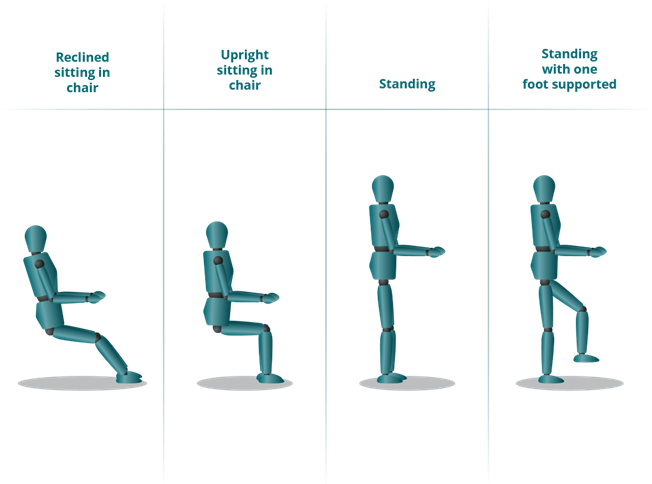Change it up: Move
Quick Start Guide: Office Poster 2
Image

- There is no single “correct” working position that fits everybody’s body, work tasks, and allows comfort for extended periods
of time. - Changing position and task regularly is critical for health and effectiveness.
- Working positions can include reclined sitting, leaning forward or standing, as well as sitting upright.
- There is no single “correct” working position that fits everybody’s work tasks and body and allows comfort for extended periods of time.
- Changing position regularly is critical to health and effectiveness.
- The working positions for a particular task depend on factors such as the concentration needed and whether long reaches are required.
- Sitting vs Standing: Spending long periods of time continuously sitting OR standing is detrimental to health. Workers generally have more difficulties continuously standing than sitting at work.
- Sitting: Best for tasks requiring high concentration, high precision or demanding visual requirements; little if any lifting or long reaches.
- Standing: Best for tasks requiring a lot of movement and time spent away from the workstation or having long reaches or lifting, e.g., a postal clerk receiving parcels.
- Sit-Stand: Best for tasks requiring high concentration, high precision or demanding visual requirements. A well-designed adjustable sit-stand desk allows change in working posture.
- Supported Standing: Best when most tasks are suitable for standing but a worker would benefit from a short break from standing, e.g., a fold down stool for a supermarket cashier to “perch” on between customers.
- Sitting and Standing: Best when workers need to be at eye level with a customer or client, when a variety of tasks are performed that require both sitting and standing positions, when a job involves movement to get to other equipment or when a worker lifts occasionally.
- All the parts of the workstation have to work together: After adjusting the individual parts of the workstation separately, fine-tune the setup so the workstation fits your body and tasks.
- Every worker has a different body. For example, some workers may find sitting more stressful than standing. This will affect which working postures they find tolerable. This is especially true for workers recovering or returning to work from MSD or other injuries and illnesses.
- Office tasks are commonly combined with non-office tasks, e.g., occasionally working on a computer terminal at the side of an assembly line. This Guide can be used for the “office” related tasks and companion document, the Quick Start Guide: General could be used for non-office related tasks.
Include breaks and pauses at work
- Changing tasks and moving between, sitting and standing, reclined sitting, or walking create breaks and pauses during work and helps avoid the negative effects of prolonged office work.
- For Sit-Stand desks, try moving between sitting and standing about every 20 minutes as a start. Listen to your body. Workers may find that more or less time sitting or standing works best for them, e,g., they find that standing is more tiring or painful than sitting for them.
- Fatigue creeps up on the body and eyes. Vary work and working positions. Move early – before you feel fatigue – and move often.
- Stretching can help.
Improve work
- Ask yourself and others, “Why do people feel fatigued or sore when doing office work?” and keep asking “why” until you get a good answer!
- Once the underlying cause of the problem has been identified, employees and managers working together can control hazards and improve work best.
- Use these ideas for any office work, whether in an office building, home office, automobile or in the field.
What are we going to do today to make our workstations and workspace better?
Whatever changes you make, check that you are not creating any new problems.
